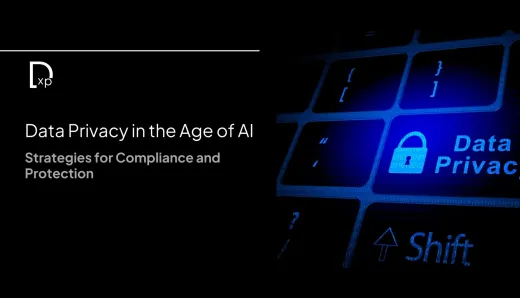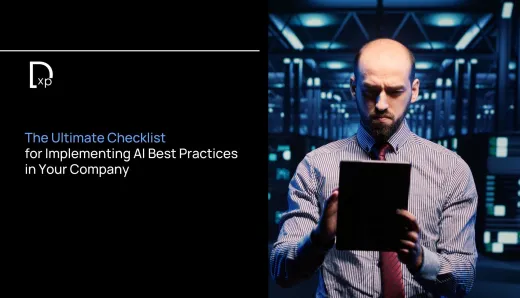Data-Driven Digital Experiences: A Marketer's Handbook

Customer expectations are evolving faster than ever. They demand personalized, seamless, and engaging interactions across all touchpoints. To meet these expectations, marketers must move beyond intuition and creativity, grounding their strategies in data. Data-driven digital experiences enhance customer satisfaction and drive business growth, providing measurable results that can be continuously optimized. For C-suite executives and marketers alike, understanding how to harness data effectively is crucial for building a robust digital strategy that delivers real impact.
This handbook serves as a comprehensive guide for marketers on how to create and manage data-driven digital experiences. We’ll explore the key components, best practices, and future trends that will help you stay ahead of the curve.

Understanding the Power of Data-Driven Digital Experiences
The power of data-driven digital experiences cannot be overstated. Data is no longer just a byproduct of customer interactions; it has become the foundation upon which successful digital strategies are built. At its core, a data-driven approach enables businesses to transform raw data into actionable insights, which are then used to create personalized, efficient, and impactful customer experiences.
Shifting from Guesswork to Precision
Historically, marketing strategies were often based on educated guesses or broad generalizations about customer behavior. However, these strategies are no longer adequate in the data-rich environment today. Data-driven strategies replace guesswork with precision, allowing marketers to understand exactly what their customers want when they want it, and how they prefer to engage with a brand.
A streaming service like Spotify uses data from millions of user interactions to curate personalized playlists. These playlists aren’t just random collections of songs; they are tailored based on listening history, favorite genres, and even the time-of-day users are most active. Increased engagement and customer retention result from this precision, which strengthens the interaction between the user and the platform.
Enhancing Customer Journeys Through Personalization
One of the most significant advantages of a data-driven digital experience is the ability to personalize every aspect of the customer journey. Delivering content, offers, and experiences that align with specific preferences and behaviors is the essence of personalization, which goes beyond simply addressing clients by name.
Consider the impact of personalization in email marketing. A data-driven email campaign might segment customers based on their past purchase behavior, browsing history, and engagement levels. By sending tailored product recommendations and personalized discounts, the campaign can significantly increase open rates, click-through rates, and conversions. This level of personalization not only boosts immediate sales but also strengthens long-term customer loyalty by making each interaction feel uniquely relevant.
Real-Time Responsiveness and Agility
The digital world moves fast, and customer expectations are constantly evolving. Data-driven strategies empower businesses to be agile and responsive, adapting quickly to changes in customer behavior and market trends. Real-time data analytics allows marketers to monitor the effectiveness of their campaigns, making adjustments on the fly to optimize results.
Consider a retail brand running a holiday promotion. By using real-time data analytics, the brand can track which products are performing well and which ones are lagging. If a particular product category isn’t selling as expected, the brand can quickly adjust its promotional strategy—perhaps by offering additional discounts or featuring the product more prominently on the homepage. This real-time responsiveness ensures that the brand maximizes its sales potential during a critical shopping period.
Building Long-Term Value and Trust
Data-driven digital experiences aren’t just about short-term gains; they’re about building long-term value and trust with customers. When customers see that a brand understands their needs and consistently delivers relevant and timely content, their trust in the brand grows. This trust is the foundation for long-term customer relationships, which are far more valuable than one-off transactions.
Trust is especially crucial in industries like finance and healthcare, where customers expect their data to be handled with care. By using data to deliver personalized experiences while also prioritizing data security and privacy, businesses in these sectors can differentiate themselves from competitors. For instance, a bank that uses customer data to offer tailored financial advice, while also being transparent about data usage and providing robust security measures, can build a loyal customer base that values both personalization and privacy.
Driving Innovation and Competitive Advantage
Finally, data-driven digital experiences are a catalyst for innovation. By continuously analyzing customer data, businesses can identify emerging trends, uncover new opportunities, and develop innovative products and services that meet the evolving needs of their customers. This ability to innovate based on data insights provides a significant competitive advantage in today’s fast-paced digital marketplace.
Take the case of a fitness app that uses data to track user workouts, diet, and sleep patterns. By analyzing this data, the app developers might discover a growing interest in mindfulness and mental health among their users. In response, they could innovate by introducing new features like guided meditation sessions or stress management tools. This enhances the user experience and positions the app as a leader in holistic health, appealing to a broader audience.
Key Components of a Data-Driven Digital Experience Strategy
Building a successful data-driven digital experience strategy requires a structured approach that incorporates several key components. Here's an overview of the key components:
1. Data Collection and Integration
Any data-driven strategy's core is its capacity to obtain and aggregate data from multiple sources. This includes data from website analytics, CRM systems, social media platforms, and customer feedback channels. Effective data integration ensures that you have a holistic view of the customer, allowing for more accurate insights and better decision-making.
Example: A retail brand might collect data from its e-commerce site, in-store purchases, social media interactions, and email campaigns. By integrating these data sources, the brand can gain a complete picture of each customer’s journey, enabling more personalized marketing efforts.
2. Advanced Analytics and Insights
The next stage after gathering data is to analyze it to find insights that can be put into practice. Advanced analytics tools, such as machine learning algorithms and predictive analytics, can help marketers identify patterns, segment audiences, and forecast future trends. These insights are critical for creating targeted campaigns that drive engagement and conversions.
Example: A travel company might use predictive analytics to determine which customers are most likely to book a vacation based on their previous browsing history and engagement with promotional content. By targeting these customers with personalized offers, the company can increase its conversion rate and improve ROI.
3. Personalization at Scale
Personalization is the cornerstone of a data-driven digital experience. By using data to understand individual customer preferences, marketers can tailor content, offers, and interactions to meet the unique needs of each customer. However, personalization must be scalable to be effective. This means using automation and AI to deliver personalized experiences to large audiences without sacrificing quality.
Example: Amazon’s recommendation engine is a perfect example of personalization at scale. The platform uses data from millions of users to provide personalized product suggestions, ensuring that each customer receives relevant recommendations based on their browsing and purchase history. This approach not only enhances the customer experience but also drives sales.
4. Continuous Optimization
Customer expectations and the digital world are constantly evolving. To stay ahead, marketers must adopt a mindset of continuous optimization. This involves regularly reviewing performance metrics, conducting A/B testing, and using real-time data to refine strategies. Your digital experience will always be relevant and efficient due to regular adjustments.
Example: A SaaS company might regularly test different landing page designs to see which one leads to higher sign-up rates. By continuously optimizing these pages based on data insights, the company can improve its conversion rates and drive growth.
5. Privacy and Compliance
As data-driven strategies become more sophisticated, it’s essential to prioritize privacy and compliance. Customers are increasingly concerned about how their data is used, and regulations like GDPR and CCPA impose strict guidelines on data handling. Marketers must ensure that their data practices are transparent, ethical, and compliant with all relevant regulations.
Example: A financial services firm might implement strict data governance policies to ensure that customer information is protected and used responsibly. The firm can build trust and avoid potential legal issues by being transparent about data usage and providing customers with control over their data.
The Future of Data-Driven Digital Experiences
As technology continues to advance, the future of data-driven digital experiences looks promising. Here are some trends that marketers should watch for in the coming years:
- AI-Driven Personalization: AI will play an increasingly important role in personalizing digital experiences. From chatbots that provide real-time customer support to algorithms that predict customer needs, AI will enable more sophisticated and intuitive interactions.
- Omnichannel Integration: The future of digital experiences lies in seamless integration across all channels. Customers expect a consistent experience whether they’re interacting with a brand online, in-store, or through social media. Data-driven strategies will enable marketers to deliver a unified experience across all touchpoints.
- Data Ethics and Transparency: As data collection becomes more pervasive, the focus on data ethics and transparency will intensify. Brands that prioritize ethical data practices and are transparent with their customers will gain a competitive edge in building trust and loyalty.
- Real-Time Customer Insights: Real-time data analytics will become more accessible, allowing marketers to make instant decisions based on the latest customer behaviors. This will lead to more agile and responsive marketing strategies.
Empowering Marketers with Data
For C-suite executives, the roadmap to successful data-driven digital experiences lies in empowering your marketing teams with the right tools, training, and resources. By fostering a data-centric culture within your organization, you can ensure that every decision is informed by accurate, actionable insights.
The journey to creating exceptional digital experiences is ongoing, requiring continuous learning and adaptation. As marketers, your goal should be to stay ahead of the curve, leveraging data to anticipate customer needs, deliver personalized experiences, and drive business growth.
Ready to harness the power of data-driven digital experiences?
Click here to read our related blog on Unleashing the Power of Digital Experience Analytics Platforms. Explore more of our insights on our website and discover how to stay ahead in your journey to creating exceptional customer experiences.




